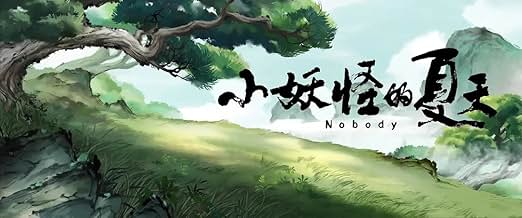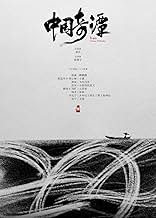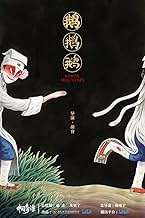IMDb-BEWERTUNG
7,6/10
449
IHRE BEWERTUNG
Eine Sammlung von 8 animierten Kurzgeschichten, die die traditionelle chinesische Kultur, die chinesische Philosophie, die Fantasie, die Ästhetik und die Entwicklung der chinesischen Gesells... Alles lesenEine Sammlung von 8 animierten Kurzgeschichten, die die traditionelle chinesische Kultur, die chinesische Philosophie, die Fantasie, die Ästhetik und die Entwicklung der chinesischen Gesellschaft zeigen.Eine Sammlung von 8 animierten Kurzgeschichten, die die traditionelle chinesische Kultur, die chinesische Philosophie, die Fantasie, die Ästhetik und die Entwicklung der chinesischen Gesellschaft zeigen.
- Hauptbesetzung
- Auszeichnungen
- 7 Gewinne & 2 Nominierungen insgesamt
Folgen durchsuchen
Empfohlene Bewertungen
10calahao
Variously translated as "Chinese Folktales" or "Chinese Bizarreries", this series is an animated anthology with eight episodes currently availiable. Essentially, this is the Chinese equivalent to Love, Death and Robots, except more tilted to the fantasy side of things.
The animation is sublime, ranging across the spectrum from Disneyesque 2D to abstract styles in 2D and CGI. The plots naturally vary wildely from each other, but they are closely tied to Chinese cultural identity, some shorts even being spin-offs of The Journey to the West.
Overall a stellar recommendation if you enjoy animation and Chinese culture.
The animation is sublime, ranging across the spectrum from Disneyesque 2D to abstract styles in 2D and CGI. The plots naturally vary wildely from each other, but they are closely tied to Chinese cultural identity, some shorts even being spin-offs of The Journey to the West.
Overall a stellar recommendation if you enjoy animation and Chinese culture.
This Chinese animation production, created by the esteemed Shanghai Animation Film Studio, stands as one of the finest in recent years. Known for their illustrious history, the studio has crafted numerous masterpieces, including the renowned "Uproar in Heaven" (1964).
Following a similar format to "Love, Death, Robots," this production showcases a collection of classic and innovative stories rooted in Chinese culture, resonating deeply with Chinese audiences. The level of production quality and storytelling expertise is truly world-class. Notably, the second episode is presented in the captivating form of traditional Chinese ink paintings, adding a unique and artistic touch to the series.
Following a similar format to "Love, Death, Robots," this production showcases a collection of classic and innovative stories rooted in Chinese culture, resonating deeply with Chinese audiences. The level of production quality and storytelling expertise is truly world-class. Notably, the second episode is presented in the captivating form of traditional Chinese ink paintings, adding a unique and artistic touch to the series.
In the last century, the leading company in China's animation industry was the Shanghai Animation Film Studio. However, in the 2010s, although the studio held a large number of characters that left a deep impression on Chinese audiences, its reputation quickly declined. It struggled to produce decent animated works, mostly rehashing old content. This piece can be seen as the Shanghai Animation Film Studio's attempt to rebuild its reputation and regain its former glory. It has been relatively successful and has helped change some people's stereotypical views on Chinese animation.
Compared to other Chinese animations from the same period, this one shows enough innovation. It uniquely chose eight different directors to direct eight different episodes, a format similar to the show Love, Death & Robots. The eight directors each brought their own creative ideas around the central theme of Chinese myths and legends, a concept never seen before in China.
Among them, there are indeed some noteworthy works, such as the highly anticipated first episode, Nobody, which focuses on a common pig demon as the main character. It subtly satirizes the tragic fate of ordinary workers under China's extreme work culture. In the ending, the little monster is initially struck dead by Sun Wukong, but the end credits reveal that it wasn't actually killed; instead, Sun Wukong helped it, transforming a tragedy into a comedy. Personally, I prefer the original tragic ending, as it better highlights the fate of small people: While Journey to the West focuses on Sun Wukong's bravery and skill, it overlooks the tragic destinies of those small demons who are forced into evil deeds, thus showing the dual nature of Sun Wukong. Though seemingly ridding the world of demons, he inadvertently ruins the bright futures of many innocents. The second episode, through the story of a boy and a goose, portrays the process of human nature being gradually consumed by desire and then awakening, with a profound theme. The simplistic art style also strengthens the main storyline.
However, this format also brings significant imbalance due to the varying levels of directing quality. This inevitably means that some episodes are masterpieces, some are mediocre, and others are downright terrible. For example, the sixth episode, Null Island, features a clichéd narrative, boring CGI, forced plot twists, and pretentious dialogue. As others have said, it's "neither Chinese nor a strange tale," making it the biggest flaw of the entire film and a major regret.
Nonetheless, as an attempt at innovation in Chinese animation, the overall viewing experience is still quite good. It demonstrates that Chinese animation has the potential to compete on a global scale and possesses limitless possibilities.
Compared to other Chinese animations from the same period, this one shows enough innovation. It uniquely chose eight different directors to direct eight different episodes, a format similar to the show Love, Death & Robots. The eight directors each brought their own creative ideas around the central theme of Chinese myths and legends, a concept never seen before in China.
Among them, there are indeed some noteworthy works, such as the highly anticipated first episode, Nobody, which focuses on a common pig demon as the main character. It subtly satirizes the tragic fate of ordinary workers under China's extreme work culture. In the ending, the little monster is initially struck dead by Sun Wukong, but the end credits reveal that it wasn't actually killed; instead, Sun Wukong helped it, transforming a tragedy into a comedy. Personally, I prefer the original tragic ending, as it better highlights the fate of small people: While Journey to the West focuses on Sun Wukong's bravery and skill, it overlooks the tragic destinies of those small demons who are forced into evil deeds, thus showing the dual nature of Sun Wukong. Though seemingly ridding the world of demons, he inadvertently ruins the bright futures of many innocents. The second episode, through the story of a boy and a goose, portrays the process of human nature being gradually consumed by desire and then awakening, with a profound theme. The simplistic art style also strengthens the main storyline.
However, this format also brings significant imbalance due to the varying levels of directing quality. This inevitably means that some episodes are masterpieces, some are mediocre, and others are downright terrible. For example, the sixth episode, Null Island, features a clichéd narrative, boring CGI, forced plot twists, and pretentious dialogue. As others have said, it's "neither Chinese nor a strange tale," making it the biggest flaw of the entire film and a major regret.
Nonetheless, as an attempt at innovation in Chinese animation, the overall viewing experience is still quite good. It demonstrates that Chinese animation has the potential to compete on a global scale and possesses limitless possibilities.
10zcxkfy
Absolutely masterpiece!
It has 8 short story in this series, each one has a unique but cearly Chinese art style.
Now they release 1-5 episodes,I like 1/2/5most.
The first story is about a group of little "Yao" (genie maybe?)living in Lang Lang Mountain. Oh,they just like us! Poor thing, bully by their bosses everyday TAT
I dont want to spoil, but it has a worm ending, it's beautiful,both the story and picture.
PS: If you know something about Chinese great classic novel "Journey to the west", you will enjoy it more.
The second episode is base on one of Chinese old story called Yang Xian schoolar,dated back 1500 years ago. It is creepy and philosophical,and open to interpretation in many ways.
Episode 5 is really lovely! So cute! The picture adopts the style of paper cutting,very delicate.
It has 8 short story in this series, each one has a unique but cearly Chinese art style.
Now they release 1-5 episodes,I like 1/2/5most.
The first story is about a group of little "Yao" (genie maybe?)living in Lang Lang Mountain. Oh,they just like us! Poor thing, bully by their bosses everyday TAT
I dont want to spoil, but it has a worm ending, it's beautiful,both the story and picture.
PS: If you know something about Chinese great classic novel "Journey to the west", you will enjoy it more.
The second episode is base on one of Chinese old story called Yang Xian schoolar,dated back 1500 years ago. It is creepy and philosophical,and open to interpretation in many ways.
Episode 5 is really lovely! So cute! The picture adopts the style of paper cutting,very delicate.
Wusstest du schon
- VerbindungenSpin-off Nobody (2025)
Top-Auswahl
Melde dich zum Bewerten an und greife auf die Watchlist für personalisierte Empfehlungen zu.
- How many seasons does Yao-Chinese Folktales have?Powered by Alexa
Details
- Laufzeit20 Minuten
- Farbe
Zu dieser Seite beitragen
Bearbeitung vorschlagen oder fehlenden Inhalt hinzufügen
















